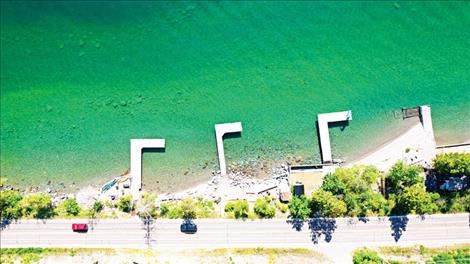Frustration builds as Flathead Lake continues to drop
Days after federal managers rejected a plan to release more water from the Hungry Horse Dam, Flathead Lake was almost two feet below full pool.
Hey savvy news reader! Thanks for choosing local.
You are now reading
3 of 3 free articles.
News from Justin Franz, Montana Free Press
FLATHEAD LAKE — Elected officials in northwest Montana are expressing frustration after the Bureau of Reclamation, which manages the many dams and reservoirs of the Columbia River Basin, rejected a plan to send water from the Hungry Horse Reservoir to raise Flathead Lake, one of the key components of the region’s tourism-driven economy. The rejection came as the lake was nearly two feet below full pool, a record low for this time of year.
Since mid-June, Flathead Lake has dropped nearly 24 inches, from about 2,893 feet datum (the standard measure to gauge water levels in lakes) to 2,891.04 feet as of mid-day Monday. Water managers blamed the less-than-steller snowpack that melted early due to a burst of warm spring weather. Northwest Montana also got little rain in the last few months, and, according to the U.S. Drought Monitor, January to May 2023 was the fifth driest start to the year in Flathead County since it started keeping records 129 years ago.
Earlier this month, dock owners and marina managers began to frantically remove boats from the lake before they got stuck in the mud below. Many docks are unusable now because of how low the water is in Flathead, which typically remains closer to full pool through Labor Day.
As the water dropped, local and state leaders called on the Bureau of Reclamation to “fill the lake” by sending water from the Hungry Horse Reservoir down the South Fork of the Flathead River to increase the level of the largest freshwater lake west of the Mississippi. Decisions like that are made by the Columbia River Technical Management Team, which has to consider the impacts on the entire river system from Montana to the Pacific Ocean, as well as the needs of species downstream like the bull trout. Presently, the Séliš Ksanka QÍispé Dam [formally the Kerr Dam] on the south end of Flathead Lake is releasing the minimum amount of water it legally can to maintain streamflows.
On Friday, the technical team rejected a formal request by Gov. Greg Gianforte to release more water out of Hungry Horse. The team stated that doing so could jeopardize the water supply later this year and even into the next.
Brian Lipscomb, CEO of Energy Keepers Inc., the company that manages Séliš Ksanka QÍispé Dam for the Confederated Salish and Kootenai Tribes, said that was ultimately the right decision. In order to raise Flathead Lake even a foot, Lipscomb said, the company would have to lower Hungry Horse by five feet.
Lipscomb said current streamflow projections for the rest of the summer show that Flathead Lake will likely level out this week and stay 24 inches below full pool until September.
But local and federal officials are frustrated with the technical team’s decision, stating that businesses that rely on the lake and farmers who need water for their fields are being jeopardized.
“I wish we could do more to help local businesses because they’re the ones that are going to take the brunt of this,” said Flathead County Commissioner Brad Abell.
Commissioner Randy Brodehl blamed federal water managers who he said were unwilling to help the people of northwest Montana.
“In my opinion, bureaucracy has won this battle against the citizens of the Flathead Valley,” he said.
Rep. Ryan Zinke suggested taking funding away from the Bureau of Reclamation, writing that Congress should use “the power of the purse” to demand that water managers prioritize multiple uses of the water it manages, including recreation.
“Let’s be clear, the Commissioner of Reclamation has the authority to make the executive decision and does not need to bow to the unelected bureaucrats at the Technical Management Team who care more about fish than people,” Zinke said in a statement to the press. “[The Bureau of Reclamation] does not lack authority. The only thing they lack is leadership.”
While some blamed the government, Lipscomb said he was placing the blame squarely on the drought. He said that people in the region should prepare for more extreme summers and that releasing water from one reservoir to another likely wouldn’t fix that.
“We’ll manage the water we have, but you can’t fix climate change with just two reservoirs,” he said earlier this month. “This is just the tip of the iceberg. I don’t think this is going to be a once-in-a-lifetime event. I think the frequency of these types of summers will only continue.”

















